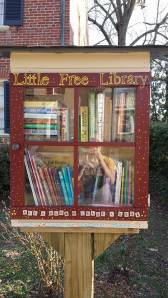Since I'm only about 1/3 of the way through my next book, I thought this would be a great opportunity to share an exciting event that's occurred in my wonderful little neighborhood. We now have a brand new Little Free Library up and running!
If you've never heard of this program and love to read - you need to pay their website a visit. It's an awesome organization started a few years ago, that has gone from one man's tribute to his mother to a worldwide initiative that promotes literacy. You may have even seen some of these cute little boxes around your town. It's basic idea is "Leave a book, Take a book" - and it's all free. Here's a picture of the new one in my neighborhood - so cute!
As much as I love my Kindle, there is just something indescribable about a physical, paper book that you hold in your hands. It has a different feeling about it and transports you away from reality in a way that my Kindle just can't. That's why I love the idea of these Little Free Libraries so much. It's a great way to get people reading and to bring neighborhoods together!
It's easy to get started with your own Little Free Library so if you don't have one near you (or even if you do!) think about joining the movement and setting up your own library. You can either build your own (if you are super handy!) or you can purchase one through their website. There is a one-time fee to make your library "official" and they will send you a packet with everything you need to get started and to keep your library going.
So go either get one started or check one out that's near you and let me know what you think!

